TAXATION LAW 11: Comprehensive Analysis of CGT and Deductions
VerifiedAdded on 2022/08/24
|13
|2709
|25
Homework Assignment
AI Summary
This taxation law assignment analyzes several scenarios related to capital gains tax (CGT) and deductions. The first part addresses CGT implications from the sale of land, shares, and collectables, along with personal use assets. It examines acquisition costs, incidental costs, property ownership costs, capital improvements, and title costs, referencing relevant sections of the ITAA 1997. The second part of the assignment focuses on the deductibility of various expenses, including travel, relocation, uniforms, childcare, phone calls, food, fines, and travel to/from work, referencing key legal precedents such as Maddalena v FCT, Fullerton v FCT, and FCT v Mansfield. The assignment provides a detailed analysis of each scenario, applying relevant tax laws and court decisions to determine the tax implications.
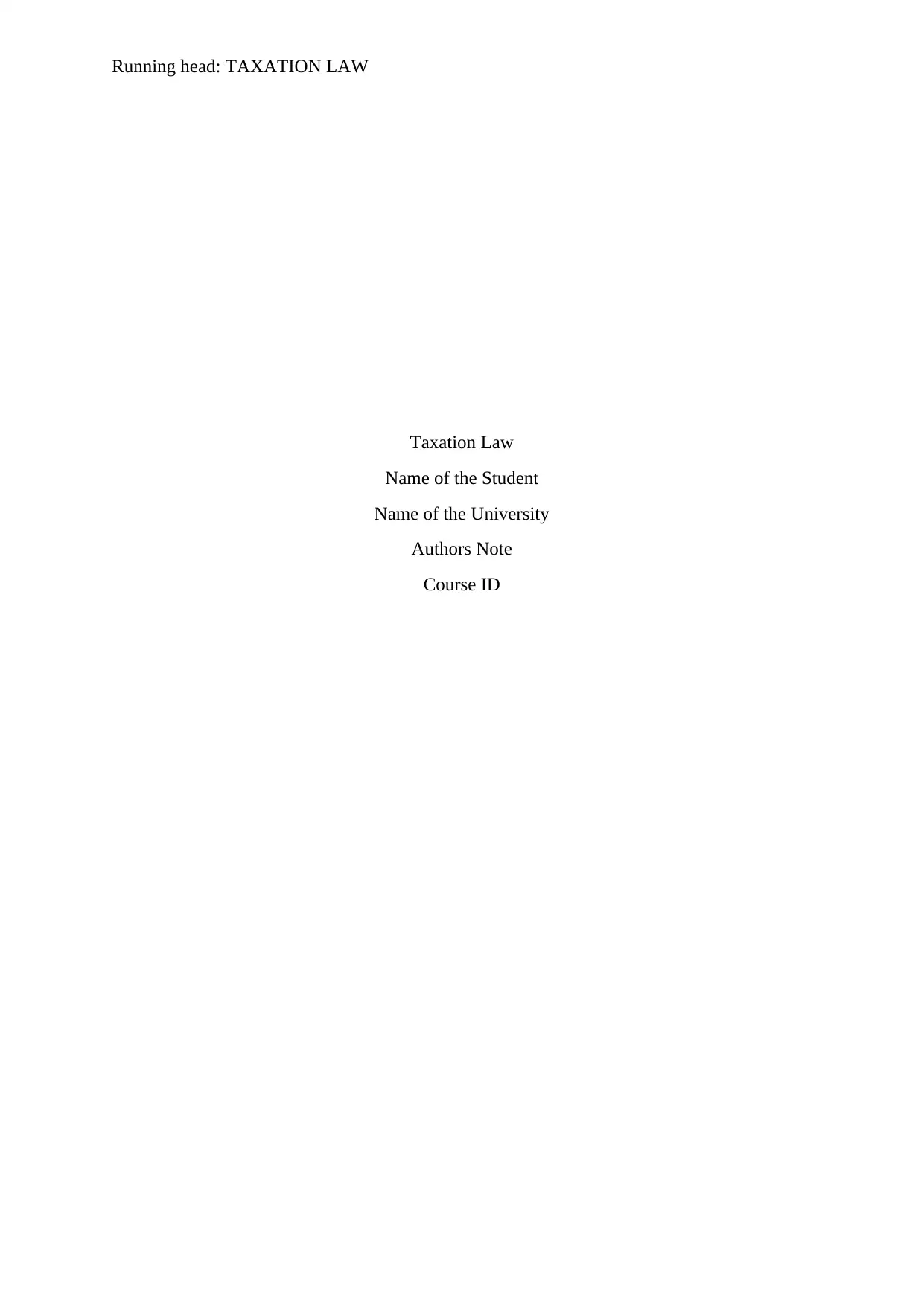
Running head: TAXATION LAW
Taxation Law
Name of the Student
Name of the University
Authors Note
Course ID
Taxation Law
Name of the Student
Name of the University
Authors Note
Course ID
Paraphrase This Document
Need a fresh take? Get an instant paraphrase of this document with our AI Paraphraser
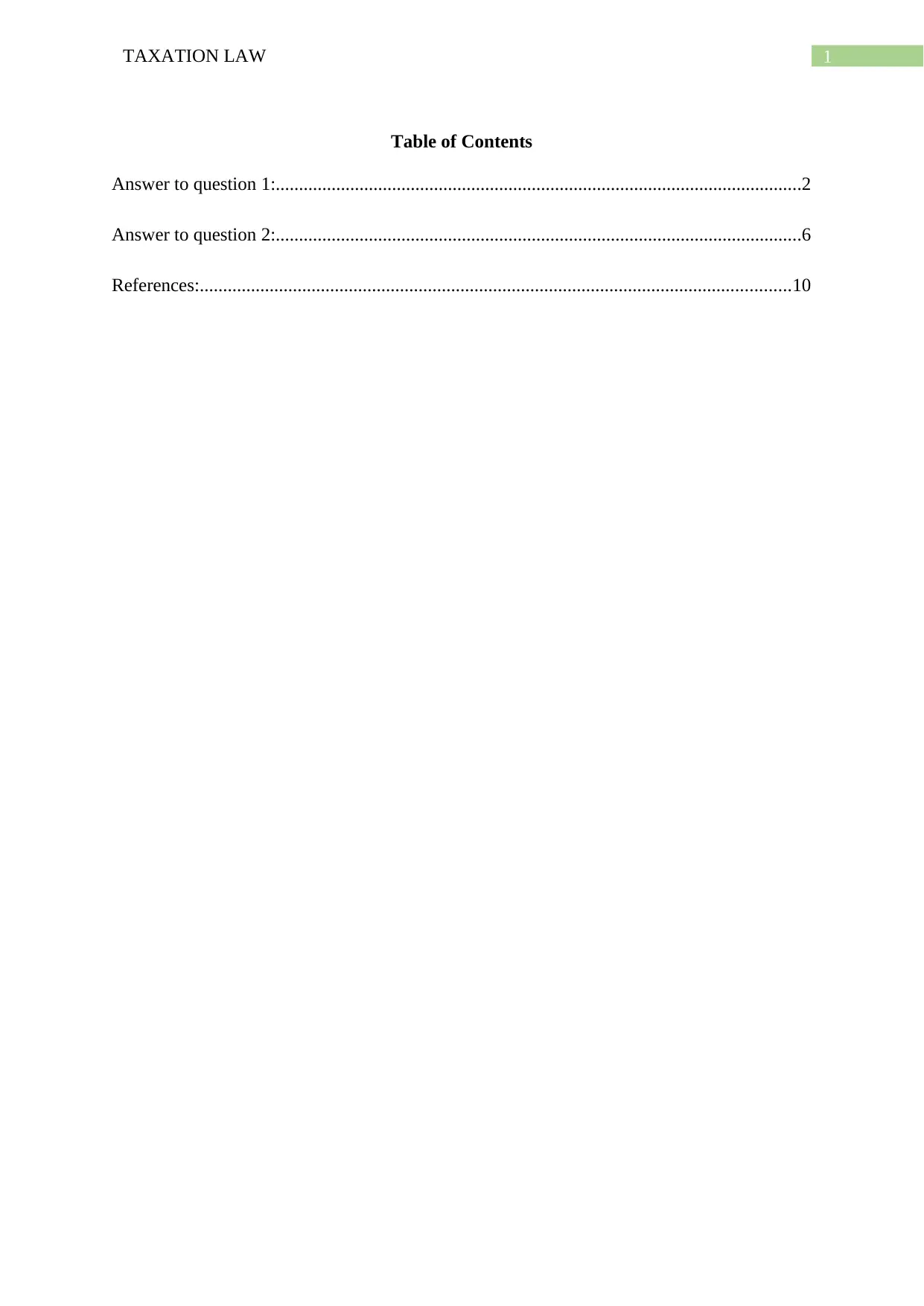
1TAXATION LAW
Table of Contents
Answer to question 1:.................................................................................................................2
Answer to question 2:.................................................................................................................6
References:...............................................................................................................................10
Table of Contents
Answer to question 1:.................................................................................................................2
Answer to question 2:.................................................................................................................6
References:...............................................................................................................................10
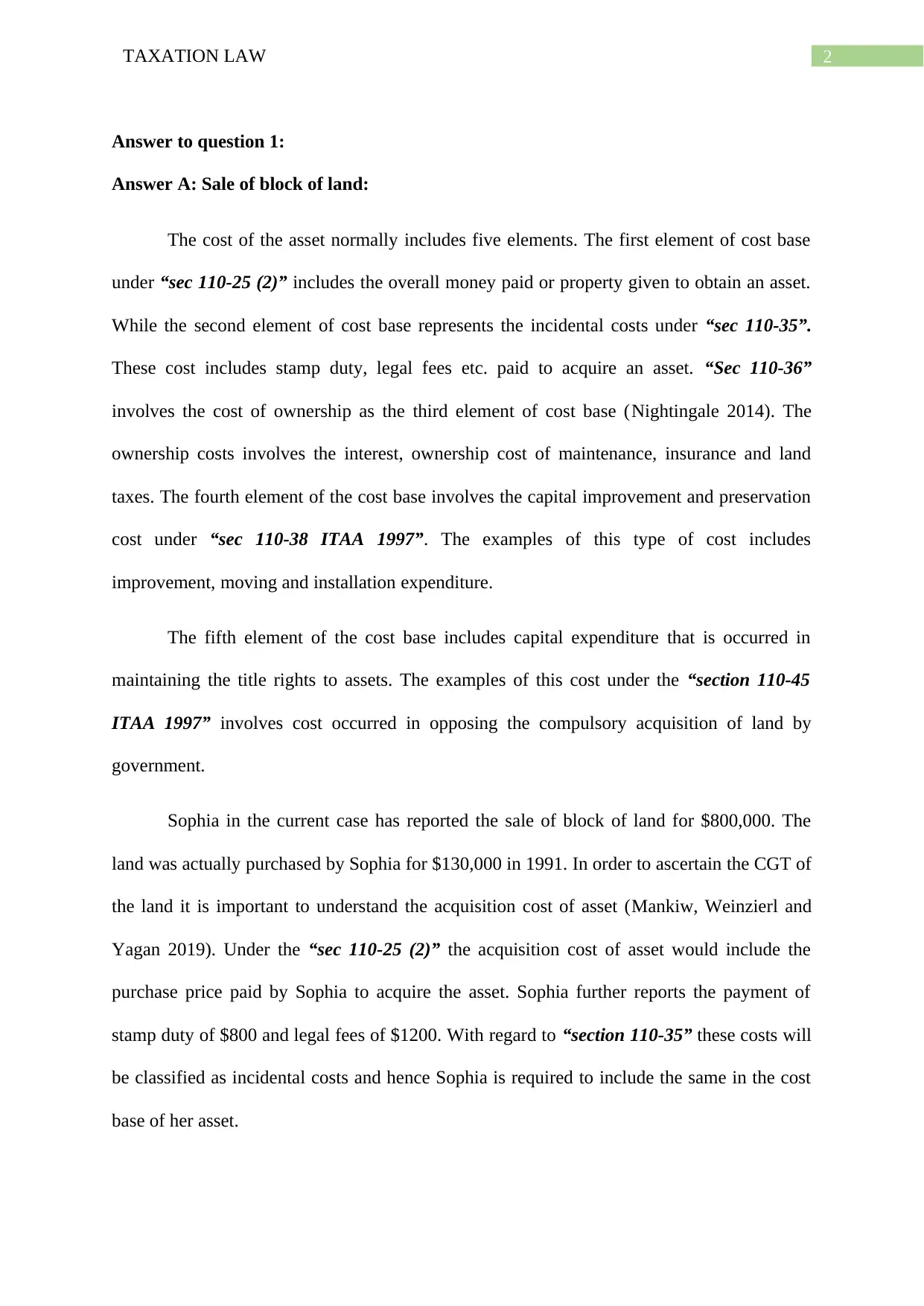
2TAXATION LAW
Answer to question 1:
Answer A: Sale of block of land:
The cost of the asset normally includes five elements. The first element of cost base
under “sec 110-25 (2)” includes the overall money paid or property given to obtain an asset.
While the second element of cost base represents the incidental costs under “sec 110-35”.
These cost includes stamp duty, legal fees etc. paid to acquire an asset. “Sec 110-36”
involves the cost of ownership as the third element of cost base (Nightingale 2014). The
ownership costs involves the interest, ownership cost of maintenance, insurance and land
taxes. The fourth element of the cost base involves the capital improvement and preservation
cost under “sec 110-38 ITAA 1997”. The examples of this type of cost includes
improvement, moving and installation expenditure.
The fifth element of the cost base includes capital expenditure that is occurred in
maintaining the title rights to assets. The examples of this cost under the “section 110-45
ITAA 1997” involves cost occurred in opposing the compulsory acquisition of land by
government.
Sophia in the current case has reported the sale of block of land for $800,000. The
land was actually purchased by Sophia for $130,000 in 1991. In order to ascertain the CGT of
the land it is important to understand the acquisition cost of asset (Mankiw, Weinzierl and
Yagan 2019). Under the “sec 110-25 (2)” the acquisition cost of asset would include the
purchase price paid by Sophia to acquire the asset. Sophia further reports the payment of
stamp duty of $800 and legal fees of $1200. With regard to “section 110-35” these costs will
be classified as incidental costs and hence Sophia is required to include the same in the cost
base of her asset.
Answer to question 1:
Answer A: Sale of block of land:
The cost of the asset normally includes five elements. The first element of cost base
under “sec 110-25 (2)” includes the overall money paid or property given to obtain an asset.
While the second element of cost base represents the incidental costs under “sec 110-35”.
These cost includes stamp duty, legal fees etc. paid to acquire an asset. “Sec 110-36”
involves the cost of ownership as the third element of cost base (Nightingale 2014). The
ownership costs involves the interest, ownership cost of maintenance, insurance and land
taxes. The fourth element of the cost base involves the capital improvement and preservation
cost under “sec 110-38 ITAA 1997”. The examples of this type of cost includes
improvement, moving and installation expenditure.
The fifth element of the cost base includes capital expenditure that is occurred in
maintaining the title rights to assets. The examples of this cost under the “section 110-45
ITAA 1997” involves cost occurred in opposing the compulsory acquisition of land by
government.
Sophia in the current case has reported the sale of block of land for $800,000. The
land was actually purchased by Sophia for $130,000 in 1991. In order to ascertain the CGT of
the land it is important to understand the acquisition cost of asset (Mankiw, Weinzierl and
Yagan 2019). Under the “sec 110-25 (2)” the acquisition cost of asset would include the
purchase price paid by Sophia to acquire the asset. Sophia further reports the payment of
stamp duty of $800 and legal fees of $1200. With regard to “section 110-35” these costs will
be classified as incidental costs and hence Sophia is required to include the same in the cost
base of her asset.
⊘ This is a preview!⊘
Do you want full access?
Subscribe today to unlock all pages.

Trusted by 1+ million students worldwide
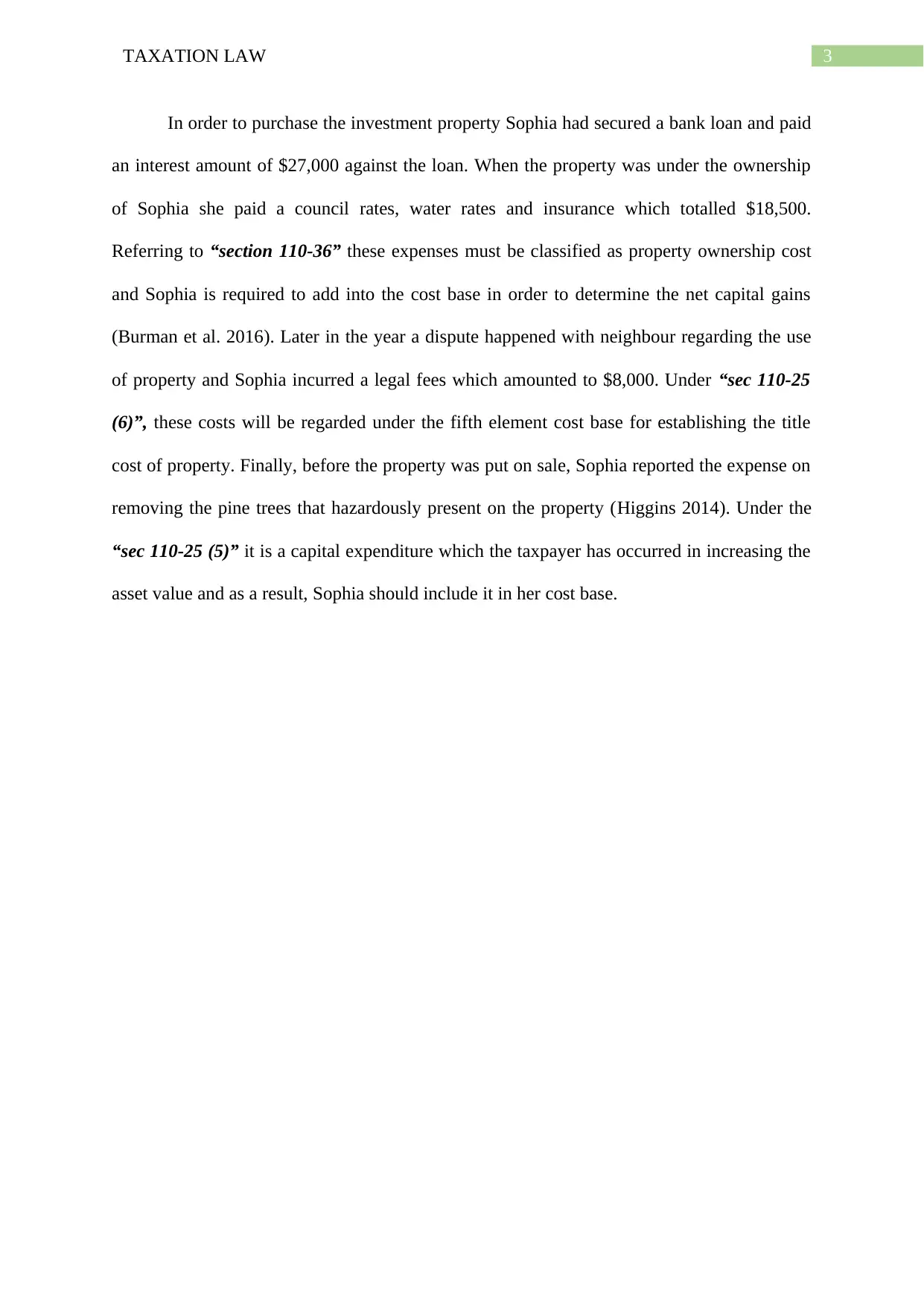
3TAXATION LAW
In order to purchase the investment property Sophia had secured a bank loan and paid
an interest amount of $27,000 against the loan. When the property was under the ownership
of Sophia she paid a council rates, water rates and insurance which totalled $18,500.
Referring to “section 110-36” these expenses must be classified as property ownership cost
and Sophia is required to add into the cost base in order to determine the net capital gains
(Burman et al. 2016). Later in the year a dispute happened with neighbour regarding the use
of property and Sophia incurred a legal fees which amounted to $8,000. Under “sec 110-25
(6)”, these costs will be regarded under the fifth element cost base for establishing the title
cost of property. Finally, before the property was put on sale, Sophia reported the expense on
removing the pine trees that hazardously present on the property (Higgins 2014). Under the
“sec 110-25 (5)” it is a capital expenditure which the taxpayer has occurred in increasing the
asset value and as a result, Sophia should include it in her cost base.
In order to purchase the investment property Sophia had secured a bank loan and paid
an interest amount of $27,000 against the loan. When the property was under the ownership
of Sophia she paid a council rates, water rates and insurance which totalled $18,500.
Referring to “section 110-36” these expenses must be classified as property ownership cost
and Sophia is required to add into the cost base in order to determine the net capital gains
(Burman et al. 2016). Later in the year a dispute happened with neighbour regarding the use
of property and Sophia incurred a legal fees which amounted to $8,000. Under “sec 110-25
(6)”, these costs will be regarded under the fifth element cost base for establishing the title
cost of property. Finally, before the property was put on sale, Sophia reported the expense on
removing the pine trees that hazardously present on the property (Higgins 2014). Under the
“sec 110-25 (5)” it is a capital expenditure which the taxpayer has occurred in increasing the
asset value and as a result, Sophia should include it in her cost base.
Paraphrase This Document
Need a fresh take? Get an instant paraphrase of this document with our AI Paraphraser
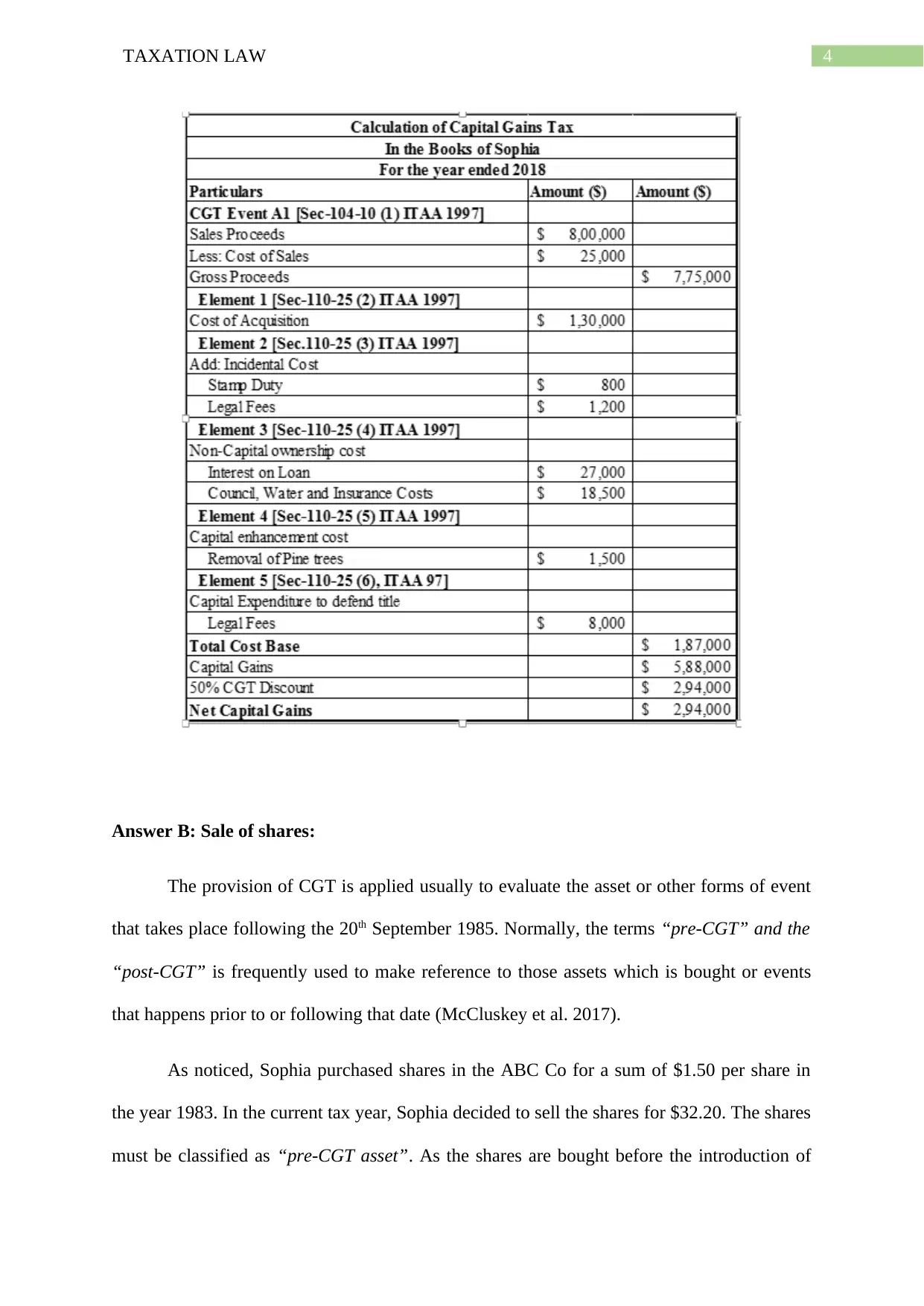
4TAXATION LAW
Answer B: Sale of shares:
The provision of CGT is applied usually to evaluate the asset or other forms of event
that takes place following the 20th September 1985. Normally, the terms “pre-CGT” and the
“post-CGT” is frequently used to make reference to those assets which is bought or events
that happens prior to or following that date (McCluskey et al. 2017).
As noticed, Sophia purchased shares in the ABC Co for a sum of $1.50 per share in
the year 1983. In the current tax year, Sophia decided to sell the shares for $32.20. The shares
must be classified as “pre-CGT asset”. As the shares are bought before the introduction of
Answer B: Sale of shares:
The provision of CGT is applied usually to evaluate the asset or other forms of event
that takes place following the 20th September 1985. Normally, the terms “pre-CGT” and the
“post-CGT” is frequently used to make reference to those assets which is bought or events
that happens prior to or following that date (McCluskey et al. 2017).
As noticed, Sophia purchased shares in the ABC Co for a sum of $1.50 per share in
the year 1983. In the current tax year, Sophia decided to sell the shares for $32.20. The shares
must be classified as “pre-CGT asset”. As the shares are bought before the introduction of
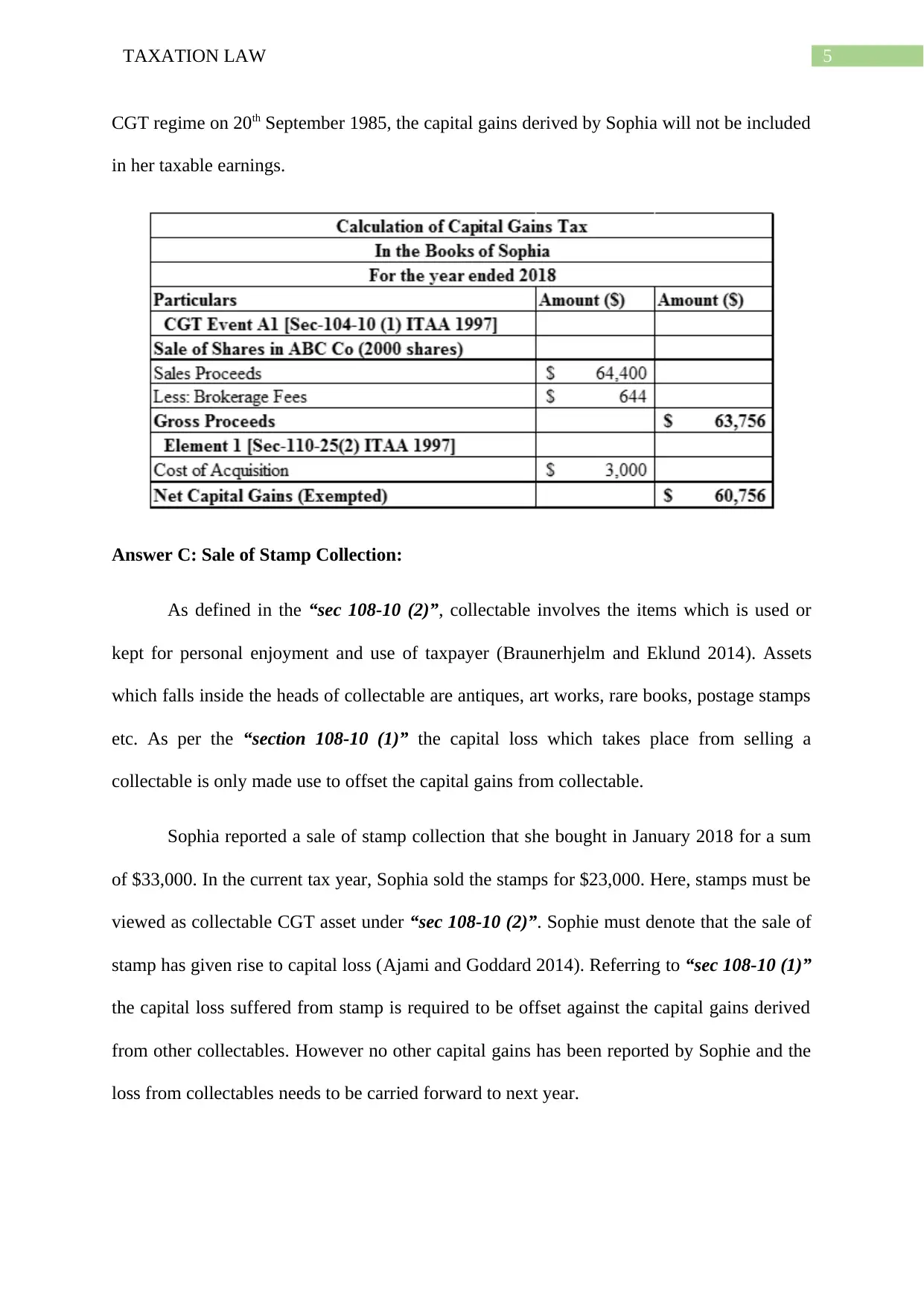
5TAXATION LAW
CGT regime on 20th September 1985, the capital gains derived by Sophia will not be included
in her taxable earnings.
Answer C: Sale of Stamp Collection:
As defined in the “sec 108-10 (2)”, collectable involves the items which is used or
kept for personal enjoyment and use of taxpayer (Braunerhjelm and Eklund 2014). Assets
which falls inside the heads of collectable are antiques, art works, rare books, postage stamps
etc. As per the “section 108-10 (1)” the capital loss which takes place from selling a
collectable is only made use to offset the capital gains from collectable.
Sophia reported a sale of stamp collection that she bought in January 2018 for a sum
of $33,000. In the current tax year, Sophia sold the stamps for $23,000. Here, stamps must be
viewed as collectable CGT asset under “sec 108-10 (2)”. Sophie must denote that the sale of
stamp has given rise to capital loss (Ajami and Goddard 2014). Referring to “sec 108-10 (1)”
the capital loss suffered from stamp is required to be offset against the capital gains derived
from other collectables. However no other capital gains has been reported by Sophie and the
loss from collectables needs to be carried forward to next year.
CGT regime on 20th September 1985, the capital gains derived by Sophia will not be included
in her taxable earnings.
Answer C: Sale of Stamp Collection:
As defined in the “sec 108-10 (2)”, collectable involves the items which is used or
kept for personal enjoyment and use of taxpayer (Braunerhjelm and Eklund 2014). Assets
which falls inside the heads of collectable are antiques, art works, rare books, postage stamps
etc. As per the “section 108-10 (1)” the capital loss which takes place from selling a
collectable is only made use to offset the capital gains from collectable.
Sophia reported a sale of stamp collection that she bought in January 2018 for a sum
of $33,000. In the current tax year, Sophia sold the stamps for $23,000. Here, stamps must be
viewed as collectable CGT asset under “sec 108-10 (2)”. Sophie must denote that the sale of
stamp has given rise to capital loss (Ajami and Goddard 2014). Referring to “sec 108-10 (1)”
the capital loss suffered from stamp is required to be offset against the capital gains derived
from other collectables. However no other capital gains has been reported by Sophie and the
loss from collectables needs to be carried forward to next year.
⊘ This is a preview!⊘
Do you want full access?
Subscribe today to unlock all pages.

Trusted by 1+ million students worldwide
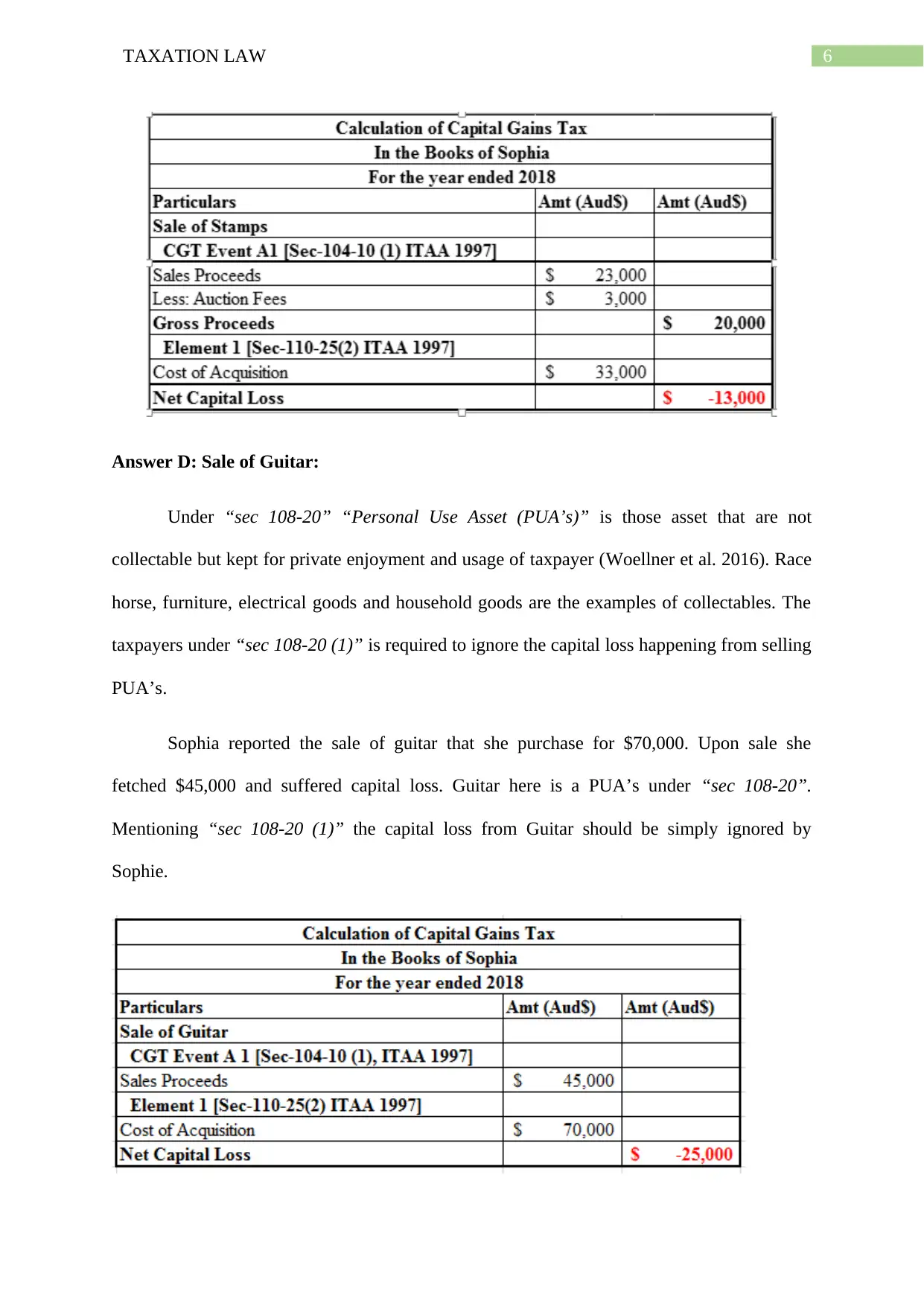
6TAXATION LAW
Answer D: Sale of Guitar:
Under “sec 108-20” “Personal Use Asset (PUA’s)” is those asset that are not
collectable but kept for private enjoyment and usage of taxpayer (Woellner et al. 2016). Race
horse, furniture, electrical goods and household goods are the examples of collectables. The
taxpayers under “sec 108-20 (1)” is required to ignore the capital loss happening from selling
PUA’s.
Sophia reported the sale of guitar that she purchase for $70,000. Upon sale she
fetched $45,000 and suffered capital loss. Guitar here is a PUA’s under “sec 108-20”.
Mentioning “sec 108-20 (1)” the capital loss from Guitar should be simply ignored by
Sophie.
Answer D: Sale of Guitar:
Under “sec 108-20” “Personal Use Asset (PUA’s)” is those asset that are not
collectable but kept for private enjoyment and usage of taxpayer (Woellner et al. 2016). Race
horse, furniture, electrical goods and household goods are the examples of collectables. The
taxpayers under “sec 108-20 (1)” is required to ignore the capital loss happening from selling
PUA’s.
Sophia reported the sale of guitar that she purchase for $70,000. Upon sale she
fetched $45,000 and suffered capital loss. Guitar here is a PUA’s under “sec 108-20”.
Mentioning “sec 108-20 (1)” the capital loss from Guitar should be simply ignored by
Sophie.
Paraphrase This Document
Need a fresh take? Get an instant paraphrase of this document with our AI Paraphraser
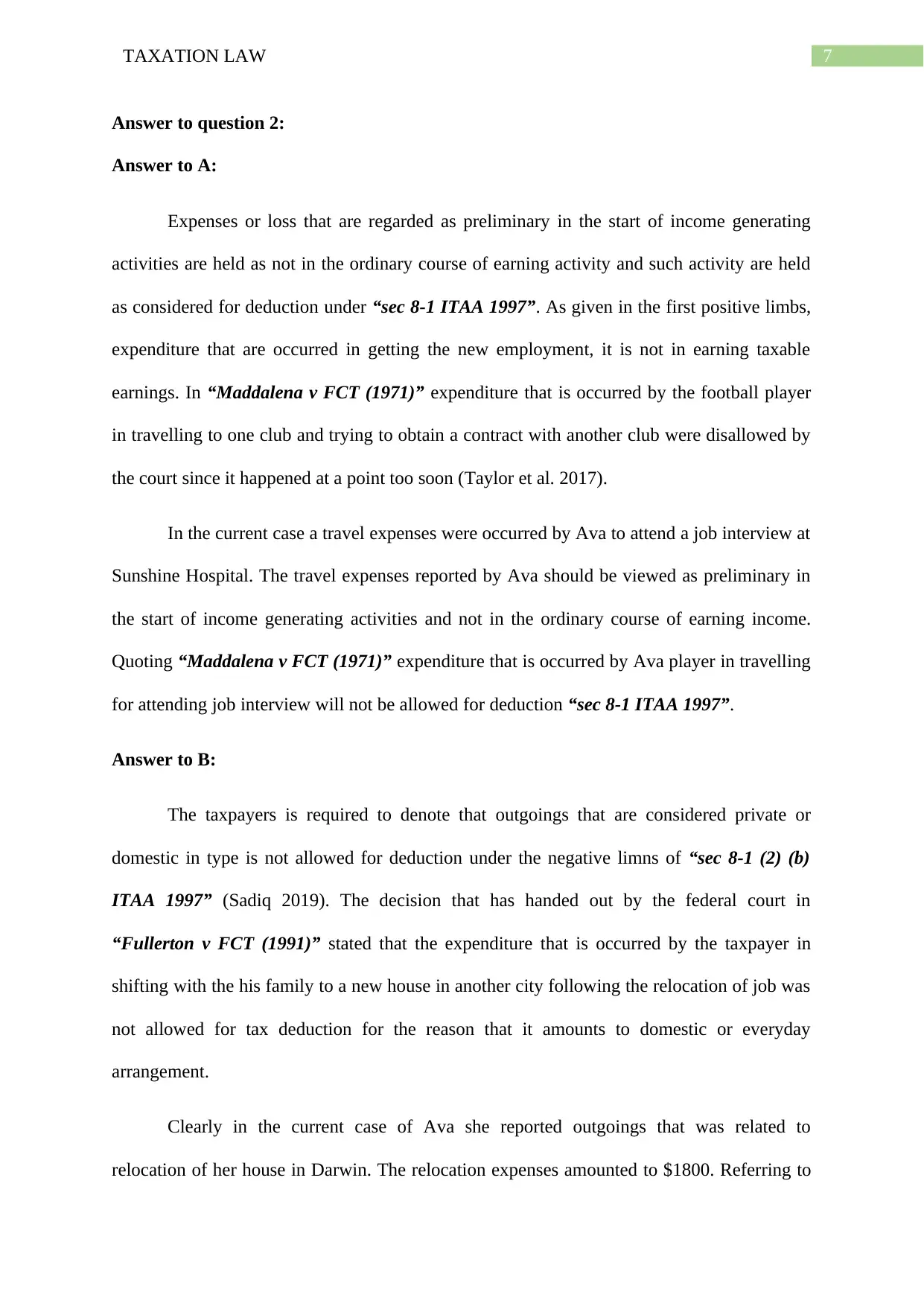
7TAXATION LAW
Answer to question 2:
Answer to A:
Expenses or loss that are regarded as preliminary in the start of income generating
activities are held as not in the ordinary course of earning activity and such activity are held
as considered for deduction under “sec 8-1 ITAA 1997”. As given in the first positive limbs,
expenditure that are occurred in getting the new employment, it is not in earning taxable
earnings. In “Maddalena v FCT (1971)” expenditure that is occurred by the football player
in travelling to one club and trying to obtain a contract with another club were disallowed by
the court since it happened at a point too soon (Taylor et al. 2017).
In the current case a travel expenses were occurred by Ava to attend a job interview at
Sunshine Hospital. The travel expenses reported by Ava should be viewed as preliminary in
the start of income generating activities and not in the ordinary course of earning income.
Quoting “Maddalena v FCT (1971)” expenditure that is occurred by Ava player in travelling
for attending job interview will not be allowed for deduction “sec 8-1 ITAA 1997”.
Answer to B:
The taxpayers is required to denote that outgoings that are considered private or
domestic in type is not allowed for deduction under the negative limns of “sec 8-1 (2) (b)
ITAA 1997” (Sadiq 2019). The decision that has handed out by the federal court in
“Fullerton v FCT (1991)” stated that the expenditure that is occurred by the taxpayer in
shifting with the his family to a new house in another city following the relocation of job was
not allowed for tax deduction for the reason that it amounts to domestic or everyday
arrangement.
Clearly in the current case of Ava she reported outgoings that was related to
relocation of her house in Darwin. The relocation expenses amounted to $1800. Referring to
Answer to question 2:
Answer to A:
Expenses or loss that are regarded as preliminary in the start of income generating
activities are held as not in the ordinary course of earning activity and such activity are held
as considered for deduction under “sec 8-1 ITAA 1997”. As given in the first positive limbs,
expenditure that are occurred in getting the new employment, it is not in earning taxable
earnings. In “Maddalena v FCT (1971)” expenditure that is occurred by the football player
in travelling to one club and trying to obtain a contract with another club were disallowed by
the court since it happened at a point too soon (Taylor et al. 2017).
In the current case a travel expenses were occurred by Ava to attend a job interview at
Sunshine Hospital. The travel expenses reported by Ava should be viewed as preliminary in
the start of income generating activities and not in the ordinary course of earning income.
Quoting “Maddalena v FCT (1971)” expenditure that is occurred by Ava player in travelling
for attending job interview will not be allowed for deduction “sec 8-1 ITAA 1997”.
Answer to B:
The taxpayers is required to denote that outgoings that are considered private or
domestic in type is not allowed for deduction under the negative limns of “sec 8-1 (2) (b)
ITAA 1997” (Sadiq 2019). The decision that has handed out by the federal court in
“Fullerton v FCT (1991)” stated that the expenditure that is occurred by the taxpayer in
shifting with the his family to a new house in another city following the relocation of job was
not allowed for tax deduction for the reason that it amounts to domestic or everyday
arrangement.
Clearly in the current case of Ava she reported outgoings that was related to
relocation of her house in Darwin. The relocation expenses amounted to $1800. Referring to
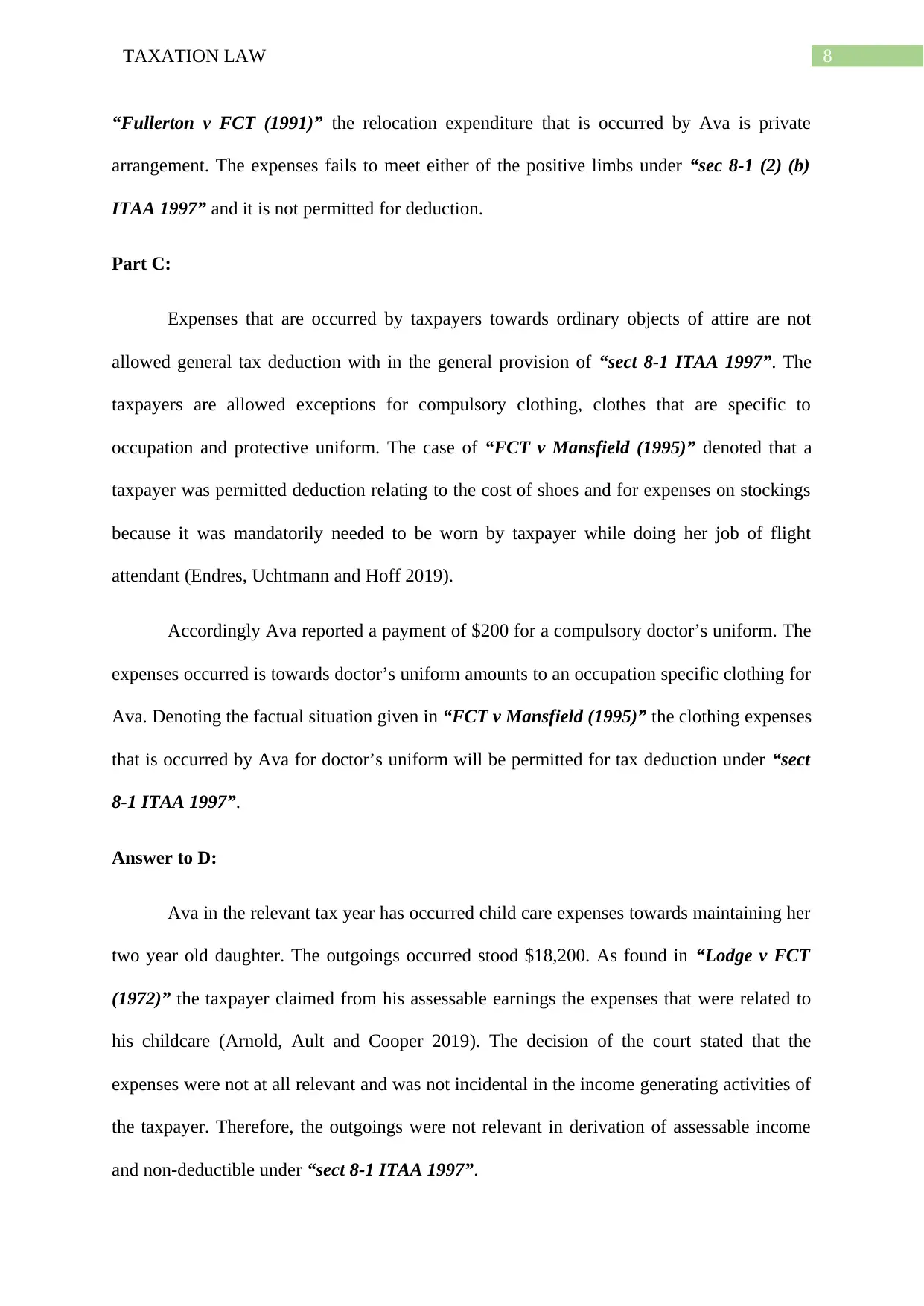
8TAXATION LAW
“Fullerton v FCT (1991)” the relocation expenditure that is occurred by Ava is private
arrangement. The expenses fails to meet either of the positive limbs under “sec 8-1 (2) (b)
ITAA 1997” and it is not permitted for deduction.
Part C:
Expenses that are occurred by taxpayers towards ordinary objects of attire are not
allowed general tax deduction with in the general provision of “sect 8-1 ITAA 1997”. The
taxpayers are allowed exceptions for compulsory clothing, clothes that are specific to
occupation and protective uniform. The case of “FCT v Mansfield (1995)” denoted that a
taxpayer was permitted deduction relating to the cost of shoes and for expenses on stockings
because it was mandatorily needed to be worn by taxpayer while doing her job of flight
attendant (Endres, Uchtmann and Hoff 2019).
Accordingly Ava reported a payment of $200 for a compulsory doctor’s uniform. The
expenses occurred is towards doctor’s uniform amounts to an occupation specific clothing for
Ava. Denoting the factual situation given in “FCT v Mansfield (1995)” the clothing expenses
that is occurred by Ava for doctor’s uniform will be permitted for tax deduction under “sect
8-1 ITAA 1997”.
Answer to D:
Ava in the relevant tax year has occurred child care expenses towards maintaining her
two year old daughter. The outgoings occurred stood $18,200. As found in “Lodge v FCT
(1972)” the taxpayer claimed from his assessable earnings the expenses that were related to
his childcare (Arnold, Ault and Cooper 2019). The decision of the court stated that the
expenses were not at all relevant and was not incidental in the income generating activities of
the taxpayer. Therefore, the outgoings were not relevant in derivation of assessable income
and non-deductible under “sect 8-1 ITAA 1997”.
“Fullerton v FCT (1991)” the relocation expenditure that is occurred by Ava is private
arrangement. The expenses fails to meet either of the positive limbs under “sec 8-1 (2) (b)
ITAA 1997” and it is not permitted for deduction.
Part C:
Expenses that are occurred by taxpayers towards ordinary objects of attire are not
allowed general tax deduction with in the general provision of “sect 8-1 ITAA 1997”. The
taxpayers are allowed exceptions for compulsory clothing, clothes that are specific to
occupation and protective uniform. The case of “FCT v Mansfield (1995)” denoted that a
taxpayer was permitted deduction relating to the cost of shoes and for expenses on stockings
because it was mandatorily needed to be worn by taxpayer while doing her job of flight
attendant (Endres, Uchtmann and Hoff 2019).
Accordingly Ava reported a payment of $200 for a compulsory doctor’s uniform. The
expenses occurred is towards doctor’s uniform amounts to an occupation specific clothing for
Ava. Denoting the factual situation given in “FCT v Mansfield (1995)” the clothing expenses
that is occurred by Ava for doctor’s uniform will be permitted for tax deduction under “sect
8-1 ITAA 1997”.
Answer to D:
Ava in the relevant tax year has occurred child care expenses towards maintaining her
two year old daughter. The outgoings occurred stood $18,200. As found in “Lodge v FCT
(1972)” the taxpayer claimed from his assessable earnings the expenses that were related to
his childcare (Arnold, Ault and Cooper 2019). The decision of the court stated that the
expenses were not at all relevant and was not incidental in the income generating activities of
the taxpayer. Therefore, the outgoings were not relevant in derivation of assessable income
and non-deductible under “sect 8-1 ITAA 1997”.
⊘ This is a preview!⊘
Do you want full access?
Subscribe today to unlock all pages.

Trusted by 1+ million students worldwide
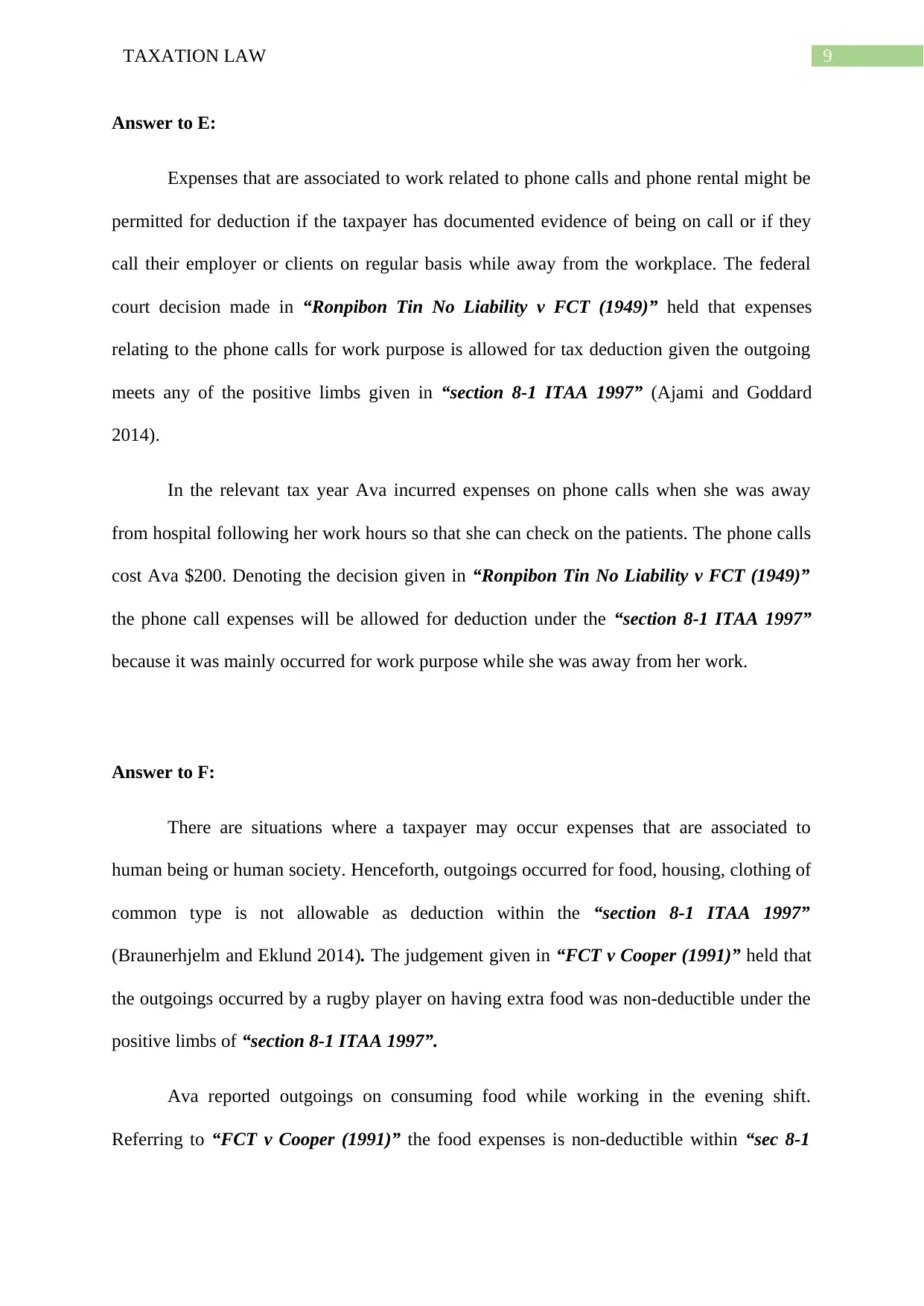
9TAXATION LAW
Answer to E:
Expenses that are associated to work related to phone calls and phone rental might be
permitted for deduction if the taxpayer has documented evidence of being on call or if they
call their employer or clients on regular basis while away from the workplace. The federal
court decision made in “Ronpibon Tin No Liability v FCT (1949)” held that expenses
relating to the phone calls for work purpose is allowed for tax deduction given the outgoing
meets any of the positive limbs given in “section 8-1 ITAA 1997” (Ajami and Goddard
2014).
In the relevant tax year Ava incurred expenses on phone calls when she was away
from hospital following her work hours so that she can check on the patients. The phone calls
cost Ava $200. Denoting the decision given in “Ronpibon Tin No Liability v FCT (1949)”
the phone call expenses will be allowed for deduction under the “section 8-1 ITAA 1997”
because it was mainly occurred for work purpose while she was away from her work.
Answer to F:
There are situations where a taxpayer may occur expenses that are associated to
human being or human society. Henceforth, outgoings occurred for food, housing, clothing of
common type is not allowable as deduction within the “section 8-1 ITAA 1997”
(Braunerhjelm and Eklund 2014). The judgement given in “FCT v Cooper (1991)” held that
the outgoings occurred by a rugby player on having extra food was non-deductible under the
positive limbs of “section 8-1 ITAA 1997”.
Ava reported outgoings on consuming food while working in the evening shift.
Referring to “FCT v Cooper (1991)” the food expenses is non-deductible within “sec 8-1
Answer to E:
Expenses that are associated to work related to phone calls and phone rental might be
permitted for deduction if the taxpayer has documented evidence of being on call or if they
call their employer or clients on regular basis while away from the workplace. The federal
court decision made in “Ronpibon Tin No Liability v FCT (1949)” held that expenses
relating to the phone calls for work purpose is allowed for tax deduction given the outgoing
meets any of the positive limbs given in “section 8-1 ITAA 1997” (Ajami and Goddard
2014).
In the relevant tax year Ava incurred expenses on phone calls when she was away
from hospital following her work hours so that she can check on the patients. The phone calls
cost Ava $200. Denoting the decision given in “Ronpibon Tin No Liability v FCT (1949)”
the phone call expenses will be allowed for deduction under the “section 8-1 ITAA 1997”
because it was mainly occurred for work purpose while she was away from her work.
Answer to F:
There are situations where a taxpayer may occur expenses that are associated to
human being or human society. Henceforth, outgoings occurred for food, housing, clothing of
common type is not allowable as deduction within the “section 8-1 ITAA 1997”
(Braunerhjelm and Eklund 2014). The judgement given in “FCT v Cooper (1991)” held that
the outgoings occurred by a rugby player on having extra food was non-deductible under the
positive limbs of “section 8-1 ITAA 1997”.
Ava reported outgoings on consuming food while working in the evening shift.
Referring to “FCT v Cooper (1991)” the food expenses is non-deductible within “sec 8-1
Paraphrase This Document
Need a fresh take? Get an instant paraphrase of this document with our AI Paraphraser

10TAXATION LAW
ITAA 1997” since it fails to meet the criteria given in first limb. The outgoings is associated
to being a part of human society and hence non-deductible under “sec 8-1 ITAA 1997”.
Answer G:
As per the “section 26-5 ITAA 1997” fines that are imposed by Australian
government is non-deductible. During the year Ava reported a speeding fine of $207 when
she was getting late for her work. Citing the “section 26-5 ITAA 1997” fines that was
imposed is non-deductible to Ava.
Answer F:
Outgoings that are occurred for Travel between home and a taxpayer’s usual place of
work in usually not permitted for tax deduction under the “sec 8-1 ITAA 1997”. As “FCT v
Lunney (1958)” taxpayers clamed outgoing associated to work and travel (Mankiw,
Weinzierl and Yagan 2019). Deduction were not permitted to taxpayer because it was not
relevant in generating chargeable earnings. Rather the outgoings were private in type.
In the current situation, Ava occurred $330 as travel outgoings to and from work.
Citing “FCT v Lunney (1958)” the travel outgoings to and from work by Ava is non-
deductible because it is private in type and not associated to derivation of taxable earnings.
As a result no deduction is allowed to Ava under “sec 8-1 ITAA 1997”.
ITAA 1997” since it fails to meet the criteria given in first limb. The outgoings is associated
to being a part of human society and hence non-deductible under “sec 8-1 ITAA 1997”.
Answer G:
As per the “section 26-5 ITAA 1997” fines that are imposed by Australian
government is non-deductible. During the year Ava reported a speeding fine of $207 when
she was getting late for her work. Citing the “section 26-5 ITAA 1997” fines that was
imposed is non-deductible to Ava.
Answer F:
Outgoings that are occurred for Travel between home and a taxpayer’s usual place of
work in usually not permitted for tax deduction under the “sec 8-1 ITAA 1997”. As “FCT v
Lunney (1958)” taxpayers clamed outgoing associated to work and travel (Mankiw,
Weinzierl and Yagan 2019). Deduction were not permitted to taxpayer because it was not
relevant in generating chargeable earnings. Rather the outgoings were private in type.
In the current situation, Ava occurred $330 as travel outgoings to and from work.
Citing “FCT v Lunney (1958)” the travel outgoings to and from work by Ava is non-
deductible because it is private in type and not associated to derivation of taxable earnings.
As a result no deduction is allowed to Ava under “sec 8-1 ITAA 1997”.
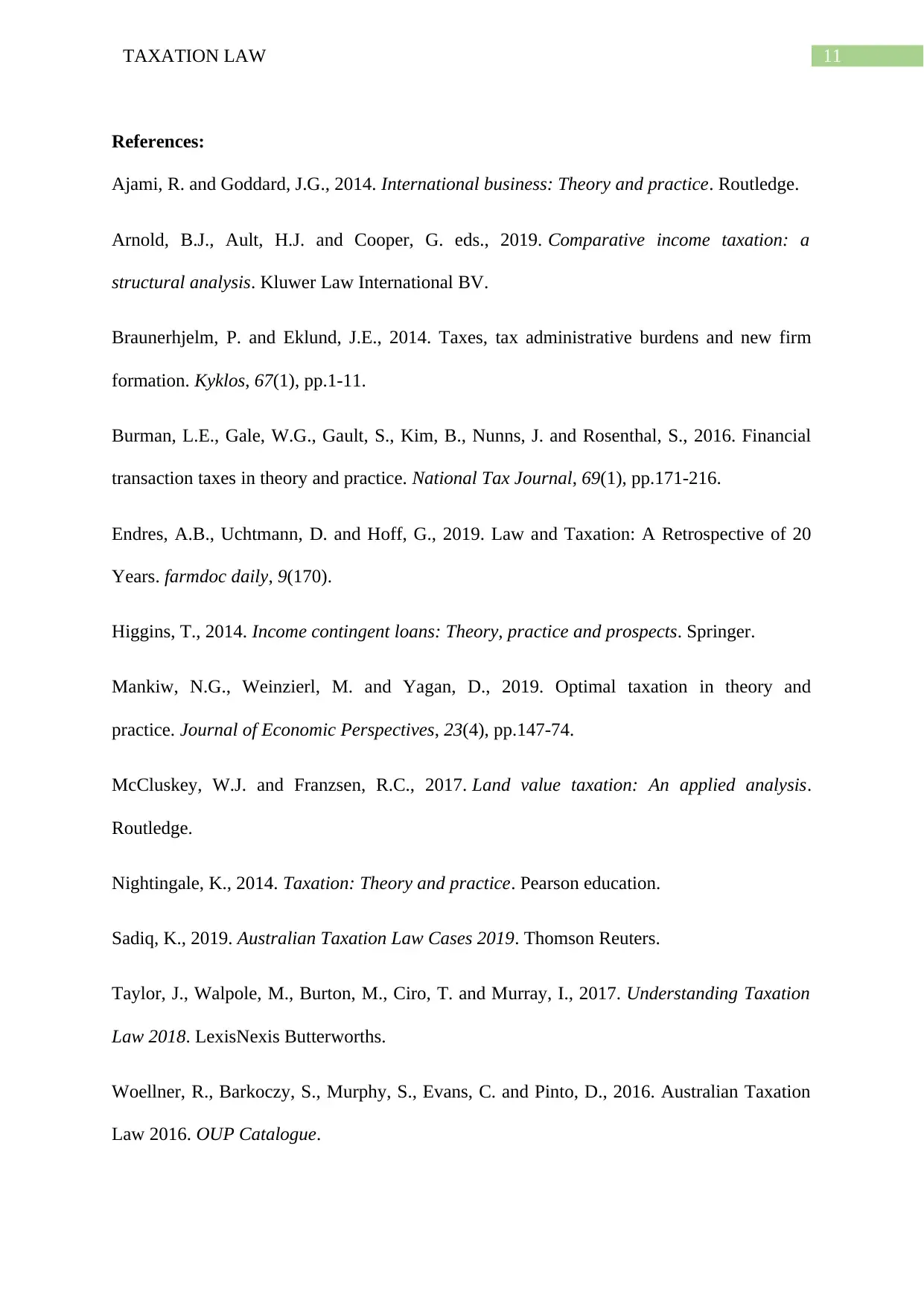
11TAXATION LAW
References:
Ajami, R. and Goddard, J.G., 2014. International business: Theory and practice. Routledge.
Arnold, B.J., Ault, H.J. and Cooper, G. eds., 2019. Comparative income taxation: a
structural analysis. Kluwer Law International BV.
Braunerhjelm, P. and Eklund, J.E., 2014. Taxes, tax administrative burdens and new firm
formation. Kyklos, 67(1), pp.1-11.
Burman, L.E., Gale, W.G., Gault, S., Kim, B., Nunns, J. and Rosenthal, S., 2016. Financial
transaction taxes in theory and practice. National Tax Journal, 69(1), pp.171-216.
Endres, A.B., Uchtmann, D. and Hoff, G., 2019. Law and Taxation: A Retrospective of 20
Years. farmdoc daily, 9(170).
Higgins, T., 2014. Income contingent loans: Theory, practice and prospects. Springer.
Mankiw, N.G., Weinzierl, M. and Yagan, D., 2019. Optimal taxation in theory and
practice. Journal of Economic Perspectives, 23(4), pp.147-74.
McCluskey, W.J. and Franzsen, R.C., 2017. Land value taxation: An applied analysis.
Routledge.
Nightingale, K., 2014. Taxation: Theory and practice. Pearson education.
Sadiq, K., 2019. Australian Taxation Law Cases 2019. Thomson Reuters.
Taylor, J., Walpole, M., Burton, M., Ciro, T. and Murray, I., 2017. Understanding Taxation
Law 2018. LexisNexis Butterworths.
Woellner, R., Barkoczy, S., Murphy, S., Evans, C. and Pinto, D., 2016. Australian Taxation
Law 2016. OUP Catalogue.
References:
Ajami, R. and Goddard, J.G., 2014. International business: Theory and practice. Routledge.
Arnold, B.J., Ault, H.J. and Cooper, G. eds., 2019. Comparative income taxation: a
structural analysis. Kluwer Law International BV.
Braunerhjelm, P. and Eklund, J.E., 2014. Taxes, tax administrative burdens and new firm
formation. Kyklos, 67(1), pp.1-11.
Burman, L.E., Gale, W.G., Gault, S., Kim, B., Nunns, J. and Rosenthal, S., 2016. Financial
transaction taxes in theory and practice. National Tax Journal, 69(1), pp.171-216.
Endres, A.B., Uchtmann, D. and Hoff, G., 2019. Law and Taxation: A Retrospective of 20
Years. farmdoc daily, 9(170).
Higgins, T., 2014. Income contingent loans: Theory, practice and prospects. Springer.
Mankiw, N.G., Weinzierl, M. and Yagan, D., 2019. Optimal taxation in theory and
practice. Journal of Economic Perspectives, 23(4), pp.147-74.
McCluskey, W.J. and Franzsen, R.C., 2017. Land value taxation: An applied analysis.
Routledge.
Nightingale, K., 2014. Taxation: Theory and practice. Pearson education.
Sadiq, K., 2019. Australian Taxation Law Cases 2019. Thomson Reuters.
Taylor, J., Walpole, M., Burton, M., Ciro, T. and Murray, I., 2017. Understanding Taxation
Law 2018. LexisNexis Butterworths.
Woellner, R., Barkoczy, S., Murphy, S., Evans, C. and Pinto, D., 2016. Australian Taxation
Law 2016. OUP Catalogue.
⊘ This is a preview!⊘
Do you want full access?
Subscribe today to unlock all pages.

Trusted by 1+ million students worldwide
1 out of 13
Related Documents
Your All-in-One AI-Powered Toolkit for Academic Success.
+13062052269
info@desklib.com
Available 24*7 on WhatsApp / Email
![[object Object]](/_next/static/media/star-bottom.7253800d.svg)
Unlock your academic potential
Copyright © 2020–2025 A2Z Services. All Rights Reserved. Developed and managed by ZUCOL.





